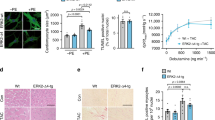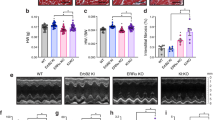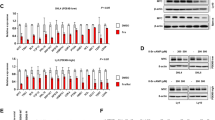Abstract
Amplification of the gene encoding the ErbB2 (Her2/neu) receptor tyrosine kinase is critical for the progression of several forms of breast cancer. In a large-scale clinical trial, treatment with Herceptin (trastuzumab), a humanized blocking antibody against ErbB2, led to marked improvement in survival. However, cardiomyopathy was uncovered as a mitigating side effect, thereby suggesting an important role for ErbB2 signaling as a modifier of human heart failure. To investigate the physiological role of ErbB2 signaling in the adult heart, we generated mice with a ventricular-restricted deletion of Erbb2. These ErbB2-deficient conditional mutant mice were viable and displayed no overt phenotype. However, physiological analysis revealed the onset of multiple independent parameters of dilated cardiomyopathy, including chamber dilation, wall thinning and decreased contractility. Additionally, cardiomyocytes isolated from these conditional mutants were more susceptible to anthracycline toxicity. ErbB2 signaling in cardiomyocytes is therefore essential for the prevention of dilated cardiomyopathy.
This is a preview of subscription content, access via your institution
Access options
Subscribe to this journal
Receive 12 print issues and online access
$209.00 per year
only $17.42 per issue
Buy this article
- Purchase on Springer Link
- Instant access to full article PDF
Prices may be subject to local taxes which are calculated during checkout





Similar content being viewed by others
References
Olayioye, M.A., Neve, R.M., Lane, H.A. & Hynes, N.E. The Erb signaling network: receptor heterodimerization in development and cancer. EMBO 19, 3159–3167 (2000).
Klapper, L., Kirschbaum, M.H., Sela, M. & Yarden, Y. Biochemical and clinical implication of the ErbB/HER signaling network of growth factor receptors. Adv. Cancer Res. 77, 25–79 (2000).
Hynes, N.E. & Stern, D.F. The biology of erbB-2/neu/HER-2 and its role in cancer. Biochem. Biophys. Acta 1198, 165–184 (1994).
Slamon, D. et al. Use of chemotherapy plus a monoclonal antibody against HER2 for metastatic breast cancer that overexpresses HER2. New Engl. J. Med. 344, 783–792 (2001).
Baselga, J. Current and planned clinical trials with trastuzumab (Herceptin). Sem. Oncol. 27, 27–32 (2000).
Sparano, J. Cardiac toxicity of tanstuzumab (herceptin): implications for the design of adjuvant trials. Sem. Oncol. 28, 20–27 (2001).
Chen, J., Kubalak, S.W. & Chien, K.R. Ventricular muscle-restricted targeting of the RXRα gene reveals a non-cell-autonomous requirement in cardiac chamber morphogenesis. Development 125, 1943–1949 (1998).
Wang, J. et al. Dilated cardiomyopathy and atrioventricular conduction blocks induced by heart-specific inactivation of mitochondrial DNA gene expression. Nature Genet. 21, 133–137 (1999).
Grove, D., Zak, R., Nair, K.G. & Aschenbrenner, V. Biochemical correlates of cardiac hypertrophy. Circ. Res. 25, 473–485 (1969).
Hirota, H. et al. Loss of a gp130 cardiac muscle cell survival pathway is a critical event in the onset of heart failure during biomechanical stress. Cell 97, 189–198 (1999).
Hunter, J.J., Grace, A. & Chien, K.R. Molecular and cellular biology of cardiac hypertrophy and failure. in Molecular Basis of Cardiovascular Disease: A Companion to Braunwald's Heart Disease (ed. Chien, K.R.) 211-250 (W.B. Saunders, Philadelphia, 1999).
Benjamin, R.S., Mason, J.W. & Billingham, M.E. Cardiac toxicity of adriamycin-DNA complex and rubidazone: evaluation by electrocardiogram and endomyocardial biopsy. Cancer Treat. Rep. 62, 935–939 (1978).
Billingham, M.E., Mason, J.W., Bristow, M.R. & Daniels, J.R. Anthracycline cardiomyopathy monitored by morphologic changes. Cancer Treat. Rep. 62, 865–872 (1978).
Ferrans, V.J. Overview of cardiac pathology in relation to anthracycline cardiotoxicity. Cancer Treat. Rep. 62, 955–961 (1978).
Rustin, P. et al. Biochemical and molecular investigations in respiratory chain deficiencies. Clin. Chim. Acta 228, 35–51 (1994).
Grady, R.M. et al. Skeletal and cardiac myopathies in mice lacking utrophin and dystrophin: a model for duchenne muscular dystrophy. Cell 90, 729–738 (1997).
Deconinck, A.E. et al. Utrophin-dystrophin-deficient mice as a model for Duchenne muscular dystrophy. Cell 90, 717–727 (1997).
Coral-Vazquez, R. et al. Disruption of the sarcoglycan-sarcospan complex in vascular smooth muscle: a novel mechanism for cardiomyopathy and muscular dystrophy. Cell 98, 465–474 (1999).
Minamisawa, S. et al. Chronic phospholamban-sarcoplasmic reticulum calcium ATPase interaction is the critical calcium cycling defect in dilated cardiomyopathy. Cell 99, 313–322 (1999).
Arber, S. et al. MLP-deficient mice exhibit a disruption of cardiac cytoarchitectural organization, dilated cardiomyopathy, and heart failure. Cell 88, 393–403 (1997).
Cho, M.-C. et al. Defective β-adrenergic receptor signaling precedes the development of dilated cardiomyopathy in transgenic mice with calsequestrin overexpression. J. Biol. Chem 274, 22251–22256 (1999).
Rohrbach, S. et al. Neuregulin in cardiac hypertrophy in rats with aortic stenosis: differential expression of ErbB2 and ErbB4 receptors. Circ. 100, 407–412 (1999).
Rochman, H.A. et al. Segregation of atrial-specific and inducible expression of an atrial natriuretic factor transgene in an in vivo murine model of cardiac hypertrophy. Proc. Natl. Acad. Sci. USA 88, 8277–8281 (1991).
Haunstetter, A. & Izumo, S. Apoptosis: Basic mechanisms and implications for cardiovascular disease. Circ. Res. 82, 1111–1129 (1998).
Christensen, G., Minamisawa, S., Gruber, P.J., Wang, Y.B. & Chien, K.R. High-efficiency, long-term cardiac expression of foreign genes in living mouse embryos and neonates. Circ. 101, 178–184 (2000).
Ikeda, S., Hamada, M. & Hiwada, K. Contribution of non-cardiomyocyte apoptosis to cardiac remodelling that occurs in the transition from compensated hypertrophy to heart failure in spontaneously hypertensive rats. Clin. Sci. 97, 239–246 (1999).
Vander Heiden, M.G. et al. Bcl-xL promotes the open configuration of the voltage-dependent anion channel and metabolite passage through the outer mitochondrial membrane. J. Biol. Chem. 276, 19414–19419 (2001).
Sun, X., Liu, X.B., Martinez, J.R., Dang, H. & Zhang, G.H. Effects of radiation on Ca2+ signaling in salivary epithelial cell lines transfected with Bcl-2 and Bcl-XL. Eur. J. Oral. Sci. 109, 103–108 (2001).
Young, R.C., Ozols, R.F. & Myers, C.E. The anthracycline antineoplastic drugs. N. Engl. J. Med. 305, 139–153 (1981).
Suzuki, T. & Miyauchi, T. A novel pharmacological action of ET-1 to prevent the cytotoxicity of doxorubicin in cardiomyocytes. Am. J. Physiol. Regul. Integr. Comp. Physiol. 280, R1399–R1406 (2001).
Lee, K.-F. et al. Requirement for neuregulin receptor ErbB2 in neural and cardiac development. Nature 378, 394–398 (1995).
Erickson, S.L. et al. ErbB3 is required for normal cerebellar and cardiac development: a comparison with ErbB2 and heregulin-deficient mice. Development 124, 4999–5011 (1997).
Britsch, S. et al. The ErbB2 and ErbB3 receptors and their ligand, neuregulin-1, are essential for development of the sympathetic nervous system. Genes Dev. 12, 1825–1836 (1998).
Zhao, Y.-Y. et al. Neuregulins promote survival and growth of cardiac myocytes: Persistence of ErbB2 and ErbB4 expression in neonatal and adult ventricular myocytes. J. Biol. Chem. 273, 10261–10269 (1998).
Agus, D., Bunn, P., Franklin, W., Garcia, M. & Ozols, R. HER-2/neu as a therapeutic target in non-small cell lung cancer, prostate cancer, and ovarian cancer. Semin. Oncol. 27, 53–63 (2000).
Tanaka, N. et al. Transthoracic echocardiography in models of cardiac disease in the mouse. Circ. 94, 1109–1117 (1996).
Chen, J. et al. Selective requirement of myosin light chain 2v in embryonic heart function. J. Biol. Chem. 273, 1252–1256 (1998).
Acknowledgements
We thank K. Campbell and Y. Kobayashi for antibodies against cytoskeletal proteins; R. Gottlieb and R. Sayen for analysis of the function of mitochondria; J. Adams for adenoviral Bcl-xL; Ma. Hoshijima for help with adenovirus injection; and N. Dalton for expertise in echocardiography. The work was supported by NIH grants and The Jean Le Ducq Foundation (to K.R.C. and K.F.L.) and support from an AHA endowed chair and Genentech, Inc (to K.R.C.). S.A.C. is a Markey Predoctoral Fellow and recipient of an award from the Chapman Foundation. K.F.L. is a Pew Scholar.
Author information
Authors and Affiliations
Corresponding author
Ethics declarations
Competing interests
K.R.C. is a consultant to Genentech in the area of heart failure and cardiomyopathy.
Rights and permissions
About this article
Cite this article
Crone, S., Zhao, YY., Fan, L. et al. ErbB2 is essential in the prevention of dilated cardiomyopathy. Nat Med 8, 459–465 (2002). https://doi.org/10.1038/nm0502-459
Received:
Accepted:
Issue Date:
DOI: https://doi.org/10.1038/nm0502-459
This article is cited by
-
Metformin alleviates ethanol-induced cardiomyocyte injury by activating AKT/Nrf2 signaling in an ErbB2-dependent manner
Molecular Biology Reports (2023)
-
MicroRNA composition of plasma extracellular vesicles: a harbinger of late cardiotoxicity of doxorubicin
Molecular Medicine (2022)
-
Integrated multi-omics analysis of adverse cardiac remodeling and metabolic inflexibility upon ErbB2 and ERRα deficiency
Communications Biology (2022)
-
Single-cell transcriptomics reveals cell-type-specific diversification in human heart failure
Nature Cardiovascular Research (2022)
-
Functional Impact and Regulation of Alternative Splicing in Mouse Heart Development and Disease
Journal of Cardiovascular Translational Research (2022)



